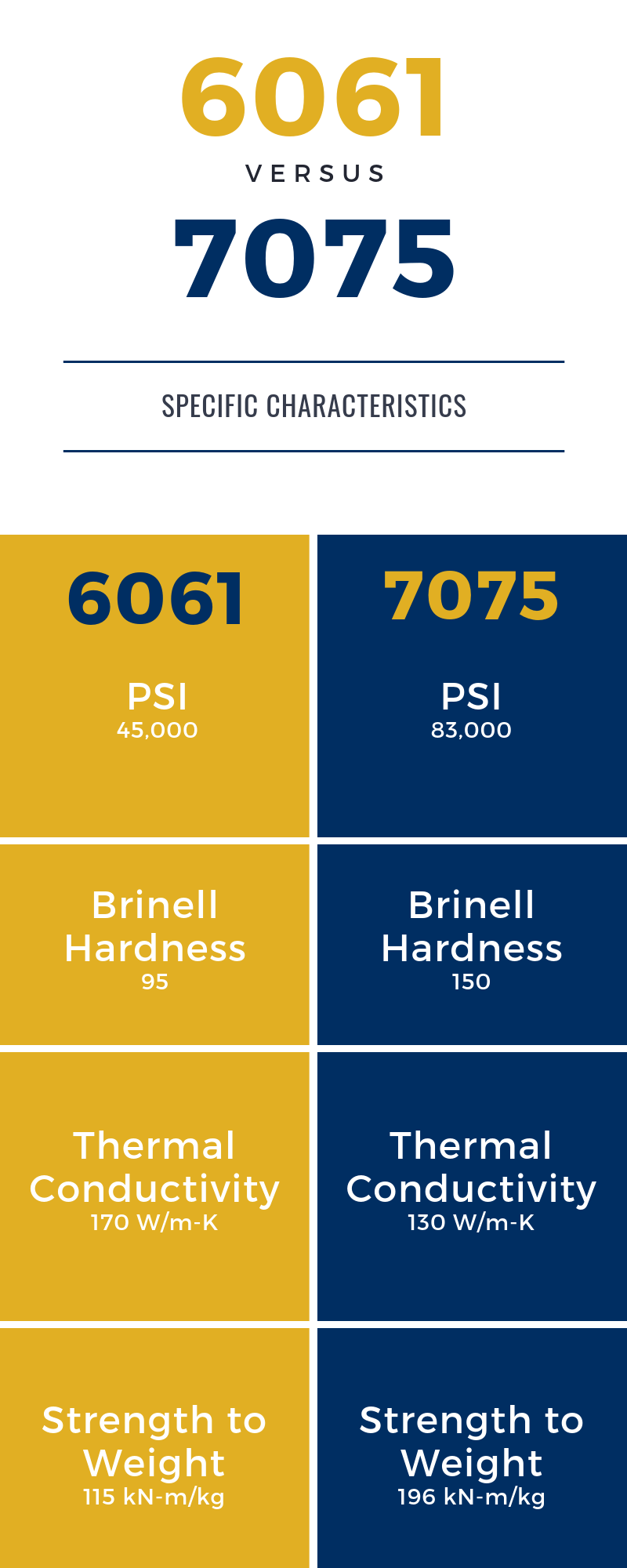Throughout the 1930s, there was an extremely high demand for lightweight materials to service the aircraft industry. Militaries around the world were in need of a metal for their aircraft that could extend the flight range, increase fuel efficiency and allow the aircraft to be more nimble in turns and intensive maneuvers. Nothing previous to 1935 had ever filled this void until 6061 was introduced that very year. The following year 7075 was developed by Japanese engineers at Sumitomo Metal Industries and soon these two aluminum alloys became the most popular and widely used in the world, going on to serve more and more industries outside of aircraft production.
What Are the Characteristics of 6061?
6061 aluminum is most known for its extreme durability, work-ability, machinability, and toughness. Not only that, but 6061 is naturally resistant to corrosion. It’s also quite popular for its versatility when it comes to applications spanning a myriad of industries. Because it is a wrought alloy and not a casting alloy, it can be rolled, forged or extruded into a variety of shapes like round bar, square bar, rectangular bar, sheet, or plate, just to name a few.
What Are the Characteristics of 7075?
7075 aluminum is best known for its strength. While not as corrosion resistant as 6061, 7075 uses zinc as its primary alloying element that allows this aluminum to compete with tensile strength of steel. It comes from the 7000 series of aluminum alloys which are known around the world for their durability and strength. While its strength is almost unmatched it is not as workable as 6061 and has a poor rating in that category. It also scores poorly in weldability and brazability. It has average corrosion resistance, not as great as 6061, and has fair machinability. To further enhance its strength, it is often heat treated, which allows it to be the superior choice in applications where you need extreme strength without adding a lot of weight.

Common Applications for 6061 Aluminum
6061 aluminum is known as the “structural” aluminum because of its workability. Because it can be rolled, rounded, squared, extruded, forged or formed into plate, it has so many uses and is found in a variety of products large and small in the world today. One industry that uses high amounts of 6061 is the automotive industry. For fuel efficiency and cost savings, 6061 aluminum is used to provide superb strength into today’s vehicles. Weighing about one-third as much as steel, aluminum not only offers strength but increases performance and improves fuel economy. Another large industry, the modern aircraft industry, still relies heavily on 6061 T651 for its strength-to-weight ratio. Since it has excellent machinability, it is the perfect choice for welding and joining different components of the aircraft. While welding may reduce strength of 6061, the aluminum can be heat treated upon finishing the weld to restore its strength. Finally, 6061 is also an excellent choice for the marine industry due to its naturally high corrosion resistance. Though 6061 aluminum is highly resistant to corrosion, additional coatings, such as painting or powder coating, are necessary to provide complete protection against the forces of Mother Nature. When these additional coatings are applied to 6061, even seawater has virtually no corrosive effect. For this reason, this alloy has been featured in boat hulls, fishing equipment, marine firearms, scuba diving equipment, docks and moorings and so much more.
Common Applications for 7075 Aluminum
When steel is too heavy but an application still requires strength, 7075 T651 plate is the most common replacement. Alloy 7075 has a much superior strength-to-weight ratio that that of steel. With 196 kn-m/kg, 7075 has the high strength and lightweight properties required to serve a number of industries, most commonly aviation, automotive and firearms. In 1936, 7075 was the answer to questions like, “How do we improve fuel efficiency of our aircraft?” and “How do we lighten the aircraft while still keeping it strong enough to handle complex maneuvers?” Although 7075 doesn’t score as high in corrosion resistance as 6061, this alloy is extremely popular in the aerospace industry. Because it uses zinc as its primary alloying element, 7075 perform exceptionally well in high stress environments. Along with the aviation industry, it is also highly popular in the automotive industry for the same reasons 6061 is. It’s also a key component to many firearms made today, with 7075 being incorporated into the designs of M16’s, AR-15’s and a variety of handguns. Being a part of the 7000 aluminum series, there are an innumerable number of products where the aluminum alloy 7075 can be found today.
Why Choose Howard Precision Metals for Your 6061 T651 and 7075 T651 plate?
At Howard Precision Metals, we are an exclusive aluminum supplier that stocks 6061 aluminum plate and 7075 aluminum plate that is produced by the finest mill sources in the market. Along with our outstanding inventory, we have over 90 years of experience and are the premier aluminum supplier in the Midwestern United States today. Come see what it’s like to experience our unmatched customer service and support.
To find out more, learn more about us or request a quote with us today.


